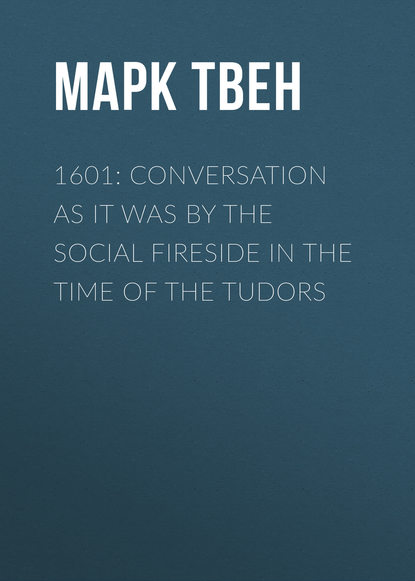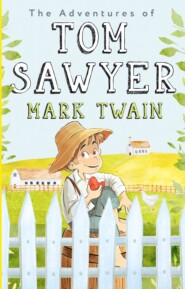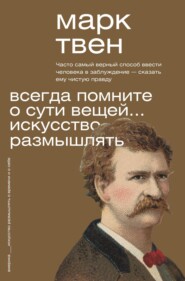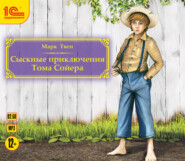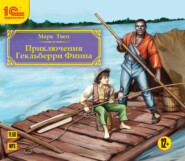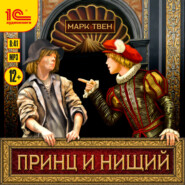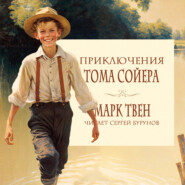По всем вопросам обращайтесь на: info@litportal.ru
(©) 2003-2024.
✖
1601: Conversation as it was by the Social Fireside in the Time of the Tudors
Настройки чтения
Размер шрифта
Высота строк
Поля
1601: Conversation as it was by the Social Fireside in the Time of the Tudors
Марк Твен
Mark Twain
1601: Conversation as it was by the Social Fireside in the Time of the Tudors
INTRODUCTION
“Born irreverent,” scrawled Mark Twain on a scratch pad, “ – like all other people I have ever known or heard of – I am hoping to remain so while there are any reverent irreverences left to make fun of.” – [Holograph manuscript of Samuel L. Clemens, in the collection of the F. J. Meine]
Mark Twain was just as irreverent as he dared be, and 1601 reveals his richest expression of sovereign contempt for overstuffed language, genteel literature, and conventional idiocies. Later, when a magazine editor apostrophized, “O that we had a Rabelais!” Mark impishly and anonymously – submitted 1601; and that same editor, a praiser of Rabelais, scathingly abused it and the sender. In this episode, as in many others, Mark Twain, the “bad boy” of American literature, revealed his huge delight in blasting the shams of contemporary hypocrisy. Too, there was always the spirit of Tom Sawyer deviltry in Mark’s make-up that prompted him, as he himself boasted, to see how much holy indignation he could stir up in the world.
WHO WROTE 1601?
The correct and complete title of 1601, as first issued, was: [Date, 1601.] ‘Conversation, as it was by the Social Fireside, in the Time of the Tudors.’ For many years after its anonymous first issue in 1880, its authorship was variously conjectured and widely disputed. In Boston, William T. Ball, one of the leading theatrical critics during the late 90’s, asserted that it was originally written by an English actor (name not divulged) who gave it to him. Ball’s original, it was said, looked like a newspaper strip in the way it was printed, and may indeed have been a proof pulled in some newspaper office. In St. Louis, William Marion Reedy, editor of the St. Louis Mirror, had seen this famous tour de force circulated in the early 80’s in galley-proof form; he first learned from Eugene Field that it was from the pen of Mark Twain.
“Many people,” said Reedy, “thought the thing was done by Field and attributed, as a joke, to Mark Twain. Field had a perfect genius for that sort of thing, as many extant specimens attest, and for that sort of practical joke; but to my thinking the humor of the piece is too mellow – not hard and bright and bitter – to be Eugene Field’s.” Reedy’s opinion hits off the fundamental difference between these two great humorists; one half suspects that Reedy was thinking of Field’s French Crisis.
But Twain first claimed his bantling from the fog of anonymity in 1906, in a letter addressed to Mr. Charles Orr, librarian of Case Library, Cleveland. Said Clemens, in the course of his letter, dated July 30, 1906, from Dublin, New Hampshire:
“The title of the piece is 1601. The piece is a supposititious conversation which takes place in Queen Elizabeth’s closet in that year, between the Queen, Ben Jonson, Beaumont, Sir Walter Raleigh, the Duchess of Bilgewater, and one or two others, and is not, as John Hay mistakenly supposes, a serious effort to bring back our literature and philosophy to the sober and chaste Elizabeth’s time; if there is a decent word findable in it, it is because I overlooked it. I hasten to assure you that it is not printed in my published writings.”
TWITTING THE REV. JOSEPH TWICHELL
The circumstances of how 1601 came to be written have since been officially revealed by Albert Bigelow Paine in ‘Mark Twain, A Bibliography’ (1912), and in the publication of Mark Twain’s Notebook (1935).
1601 was written during the summer of 1876 when the Clemens family had retreated to Quarry Farm in Elmira County, New York. Here Mrs. Clemens enjoyed relief from social obligations, the children romped over the countryside, and Mark retired to his octagonal study, which, perched high on the hill, looked out upon the valley below. It was in the famous summer of 1876, too, that Mark was putting the finishing touches to Tom Sawyer. Before the close of the same year he had already begun work on ‘The Adventures of Huckleberry Finn’, published in 1885. It is interesting to note the use of the title, the “Duke of Bilgewater,” in Huck Finn when the “Duchess of Bilgewater” had already made her appearance in 1601. Sandwiched between his two great masterpieces, Tom Sawyer and Huck Finn, the writing of 1601 was indeed a strange interlude.
During this prolific period Mark wrote many minor items, most of them rejected by Howells, and read extensively in one of his favorite books, Pepys’ Diary. Like many another writer Mark was captivated by Pepys’ style and spirit, and “he determined,” says Albert Bigelow Paine in his ‘Mark Twain, A Biography’, “to try his hand on an imaginary record of conversation and court manners of a bygone day, written in the phrase of the period. The result was ‘Fireside Conversation in the Time of Queen Elizabeth’, or as he later called it, ‘1601’. The ‘conversation’ recorded by a supposed Pepys of that period, was written with all the outspoken coarseness and nakedness of that rank day, when fireside sociabilities were limited only to the loosened fancy, vocabulary, and physical performance, and not by any bounds of convention.”
“It was written as a letter,” continues Paine, “to that robust divine, Rev. Joseph Twichell, who, unlike Howells, had no scruples about Mark’s ‘Elizabethan breadth of parlance.’”
The Rev. Joseph Twichell, Mark’s most intimate friend for over forty years, was pastor of the Asylum Hill Congregational Church of Hartford, which Mark facetiously called the “Church of the Holy Speculators,” because of its wealthy parishioners. Here Mark had first met “Joe” at a social, and their meeting ripened into a glorious, life long friendship. Twichell was a man of about Mark’s own age, a profound scholar, a devout Christian, “yet a man with an exuberant sense of humor, and a profound understanding of the frailties of mankind.” The Rev. Mr. Twichell performed the marriage ceremony for Mark Twain and solemnized the births of his children; “Joe,” his friend, counseled him on literary as well as personal matters for the remainder of Mark’s life. It is important to catch this brief glimpse of the man for whom this masterpiece was written, for without it one can not fully understand the spirit in which 1601 was written, or the keen enjoyment which Mark and “Joe” derived from it.
“SAVE ME ONE.”
The story of the first issue of 1601 is one of finesse, state diplomacy, and surreptitious printing.
The Rev. “Joe” Twichell, for whose delectation the piece had been written, apparently had pocketed the document for four long years. Then, in 1880, it came into the hands of John Hay, later Secretary of State, presumably sent to him by Mark Twain. Hay pronounced the sketch a masterpiece, and wrote immediately to his old Cleveland friend, Alexander Gunn, prince of connoisseurs in art and literature. The following correspondence reveals the fine diplomacy which made the name of John Hay known throughout the world.
DEPARTMENT OF STATE
Washington, June 21, 1880.
Dear Gunn:
Are you in Cleveland for all this week? If you will say yes by return mail, I have a masterpiece to submit to your consideration which is only in my hands for a few days.
Yours, very much worritted by the depravity of Christendom,
Hay
The second letter discloses Hay’s own high opinion of the effort and his deep concern for its safety.
June 24, 1880
My dear Gunn:
Here it is. It was written by Mark Twain in a serious effort to bring back our literature and philosophy to the sober and chaste Elizabethan standard. But the taste of the present day is too corrupt for anything so classic. He has not yet been able even to find a publisher. The Globe has not yet recovered from Downey’s inroad, and they won’t touch it.
I send it to you as one of the few lingering relics of that race of appreciative critics, who know a good thing when they see it.
Read it with reverence and gratitude and send it back to me; for Mark is impatient to see once more his wandering offspring.
Yours,
Hay.
In his third letter one can almost hear Hay’s chuckle in the certainty that his diplomatic, if somewhat wicked, suggestion would bear fruit.
Washington, D. C.July 7, 1880
My dear Gunn:
I have your letter, and the proposition which you make to pull a few proofs of the masterpiece is highly attractive, and of course highly immoral. I cannot properly consent to it, and I am afraid the great many would think I was taking an unfair advantage of his confidence. Please send back the document as soon as you can, and if, in spite of my prohibition, you take these proofs, save me one.
Very truly yours,
John Hay.
Thus was this Elizabethan dialogue poured into the moulds of cold type. According to Merle Johnson, Mark Twain’s bibliographer, it was issued in pamphlet form, without wrappers or covers; there were 8 pages of text and the pamphlet measured 7 by 8 1/2 inches. Only four copies are believed to have been printed, one for Hay, one for Gunn, and two for Twain.
“In the matter of humor,” wrote Clemens, referring to Hay’s delicious notes, “what an unsurpassable touch John Hay had!”
HUMOR AT WEST POINT
The first printing of 1601 in actual book form was “Donne at ye Academie Press,” in 1882, West Point, New York, under the supervision of Lieut. C. E. S. Wood, then adjutant of the U. S. Military Academy.
In 1882 Mark Twain and Joe Twichell visited their friend Lieut. Wood at West Point, where they learned that Wood, as Adjutant, had under his control a small printing establishment. On Mark’s return to Hartford, Wood received a letter asking if he would do Mark a great favor by printing something he had written, which he did not care to entrust to the ordinary printer. Wood replied that he would be glad to oblige. On April 3, 1882, Mark sent the manuscript:
“I enclose the original of 1603 [sic] as you suggest. I am afraid there are errors in it, also, heedlessness in antiquated spelling – e’s stuck on often at end of words where they are not strictly necessary, etc… I would go through the manuscript but I am too much driven just now, and it is not important anyway. I wish you would do me the kindness to make any and all corrections that suggest themselves to you.
“Sincerely yours,
“S. L. Clemens.”
Charles Erskine Scott Wood recalled in a foreword, which he wrote for the limited edition of 1601 issued by the Grabhorn Press, how he felt when he first saw the original manuscript. “When I read it,” writes Wood, “I felt that the character of it would be carried a little better by a printing which pretended to the eye that it was contemporaneous with the pretended ‘conversation.’
“I wrote Mark that for literary effect I thought there should be a species of forgery, though of course there was no effort to actually deceive a scholar. Mark answered that I might do as I liked; – that his only object was to secure a number of copies, as the demand for it was becoming burdensome, but he would be very grateful for any interest I brought to the doing.
Марк Твен
Mark Twain
1601: Conversation as it was by the Social Fireside in the Time of the Tudors
INTRODUCTION
“Born irreverent,” scrawled Mark Twain on a scratch pad, “ – like all other people I have ever known or heard of – I am hoping to remain so while there are any reverent irreverences left to make fun of.” – [Holograph manuscript of Samuel L. Clemens, in the collection of the F. J. Meine]
Mark Twain was just as irreverent as he dared be, and 1601 reveals his richest expression of sovereign contempt for overstuffed language, genteel literature, and conventional idiocies. Later, when a magazine editor apostrophized, “O that we had a Rabelais!” Mark impishly and anonymously – submitted 1601; and that same editor, a praiser of Rabelais, scathingly abused it and the sender. In this episode, as in many others, Mark Twain, the “bad boy” of American literature, revealed his huge delight in blasting the shams of contemporary hypocrisy. Too, there was always the spirit of Tom Sawyer deviltry in Mark’s make-up that prompted him, as he himself boasted, to see how much holy indignation he could stir up in the world.
WHO WROTE 1601?
The correct and complete title of 1601, as first issued, was: [Date, 1601.] ‘Conversation, as it was by the Social Fireside, in the Time of the Tudors.’ For many years after its anonymous first issue in 1880, its authorship was variously conjectured and widely disputed. In Boston, William T. Ball, one of the leading theatrical critics during the late 90’s, asserted that it was originally written by an English actor (name not divulged) who gave it to him. Ball’s original, it was said, looked like a newspaper strip in the way it was printed, and may indeed have been a proof pulled in some newspaper office. In St. Louis, William Marion Reedy, editor of the St. Louis Mirror, had seen this famous tour de force circulated in the early 80’s in galley-proof form; he first learned from Eugene Field that it was from the pen of Mark Twain.
“Many people,” said Reedy, “thought the thing was done by Field and attributed, as a joke, to Mark Twain. Field had a perfect genius for that sort of thing, as many extant specimens attest, and for that sort of practical joke; but to my thinking the humor of the piece is too mellow – not hard and bright and bitter – to be Eugene Field’s.” Reedy’s opinion hits off the fundamental difference between these two great humorists; one half suspects that Reedy was thinking of Field’s French Crisis.
But Twain first claimed his bantling from the fog of anonymity in 1906, in a letter addressed to Mr. Charles Orr, librarian of Case Library, Cleveland. Said Clemens, in the course of his letter, dated July 30, 1906, from Dublin, New Hampshire:
“The title of the piece is 1601. The piece is a supposititious conversation which takes place in Queen Elizabeth’s closet in that year, between the Queen, Ben Jonson, Beaumont, Sir Walter Raleigh, the Duchess of Bilgewater, and one or two others, and is not, as John Hay mistakenly supposes, a serious effort to bring back our literature and philosophy to the sober and chaste Elizabeth’s time; if there is a decent word findable in it, it is because I overlooked it. I hasten to assure you that it is not printed in my published writings.”
TWITTING THE REV. JOSEPH TWICHELL
The circumstances of how 1601 came to be written have since been officially revealed by Albert Bigelow Paine in ‘Mark Twain, A Bibliography’ (1912), and in the publication of Mark Twain’s Notebook (1935).
1601 was written during the summer of 1876 when the Clemens family had retreated to Quarry Farm in Elmira County, New York. Here Mrs. Clemens enjoyed relief from social obligations, the children romped over the countryside, and Mark retired to his octagonal study, which, perched high on the hill, looked out upon the valley below. It was in the famous summer of 1876, too, that Mark was putting the finishing touches to Tom Sawyer. Before the close of the same year he had already begun work on ‘The Adventures of Huckleberry Finn’, published in 1885. It is interesting to note the use of the title, the “Duke of Bilgewater,” in Huck Finn when the “Duchess of Bilgewater” had already made her appearance in 1601. Sandwiched between his two great masterpieces, Tom Sawyer and Huck Finn, the writing of 1601 was indeed a strange interlude.
During this prolific period Mark wrote many minor items, most of them rejected by Howells, and read extensively in one of his favorite books, Pepys’ Diary. Like many another writer Mark was captivated by Pepys’ style and spirit, and “he determined,” says Albert Bigelow Paine in his ‘Mark Twain, A Biography’, “to try his hand on an imaginary record of conversation and court manners of a bygone day, written in the phrase of the period. The result was ‘Fireside Conversation in the Time of Queen Elizabeth’, or as he later called it, ‘1601’. The ‘conversation’ recorded by a supposed Pepys of that period, was written with all the outspoken coarseness and nakedness of that rank day, when fireside sociabilities were limited only to the loosened fancy, vocabulary, and physical performance, and not by any bounds of convention.”
“It was written as a letter,” continues Paine, “to that robust divine, Rev. Joseph Twichell, who, unlike Howells, had no scruples about Mark’s ‘Elizabethan breadth of parlance.’”
The Rev. Joseph Twichell, Mark’s most intimate friend for over forty years, was pastor of the Asylum Hill Congregational Church of Hartford, which Mark facetiously called the “Church of the Holy Speculators,” because of its wealthy parishioners. Here Mark had first met “Joe” at a social, and their meeting ripened into a glorious, life long friendship. Twichell was a man of about Mark’s own age, a profound scholar, a devout Christian, “yet a man with an exuberant sense of humor, and a profound understanding of the frailties of mankind.” The Rev. Mr. Twichell performed the marriage ceremony for Mark Twain and solemnized the births of his children; “Joe,” his friend, counseled him on literary as well as personal matters for the remainder of Mark’s life. It is important to catch this brief glimpse of the man for whom this masterpiece was written, for without it one can not fully understand the spirit in which 1601 was written, or the keen enjoyment which Mark and “Joe” derived from it.
“SAVE ME ONE.”
The story of the first issue of 1601 is one of finesse, state diplomacy, and surreptitious printing.
The Rev. “Joe” Twichell, for whose delectation the piece had been written, apparently had pocketed the document for four long years. Then, in 1880, it came into the hands of John Hay, later Secretary of State, presumably sent to him by Mark Twain. Hay pronounced the sketch a masterpiece, and wrote immediately to his old Cleveland friend, Alexander Gunn, prince of connoisseurs in art and literature. The following correspondence reveals the fine diplomacy which made the name of John Hay known throughout the world.
DEPARTMENT OF STATE
Washington, June 21, 1880.
Dear Gunn:
Are you in Cleveland for all this week? If you will say yes by return mail, I have a masterpiece to submit to your consideration which is only in my hands for a few days.
Yours, very much worritted by the depravity of Christendom,
Hay
The second letter discloses Hay’s own high opinion of the effort and his deep concern for its safety.
June 24, 1880
My dear Gunn:
Here it is. It was written by Mark Twain in a serious effort to bring back our literature and philosophy to the sober and chaste Elizabethan standard. But the taste of the present day is too corrupt for anything so classic. He has not yet been able even to find a publisher. The Globe has not yet recovered from Downey’s inroad, and they won’t touch it.
I send it to you as one of the few lingering relics of that race of appreciative critics, who know a good thing when they see it.
Read it with reverence and gratitude and send it back to me; for Mark is impatient to see once more his wandering offspring.
Yours,
Hay.
In his third letter one can almost hear Hay’s chuckle in the certainty that his diplomatic, if somewhat wicked, suggestion would bear fruit.
Washington, D. C.July 7, 1880
My dear Gunn:
I have your letter, and the proposition which you make to pull a few proofs of the masterpiece is highly attractive, and of course highly immoral. I cannot properly consent to it, and I am afraid the great many would think I was taking an unfair advantage of his confidence. Please send back the document as soon as you can, and if, in spite of my prohibition, you take these proofs, save me one.
Very truly yours,
John Hay.
Thus was this Elizabethan dialogue poured into the moulds of cold type. According to Merle Johnson, Mark Twain’s bibliographer, it was issued in pamphlet form, without wrappers or covers; there were 8 pages of text and the pamphlet measured 7 by 8 1/2 inches. Only four copies are believed to have been printed, one for Hay, one for Gunn, and two for Twain.
“In the matter of humor,” wrote Clemens, referring to Hay’s delicious notes, “what an unsurpassable touch John Hay had!”
HUMOR AT WEST POINT
The first printing of 1601 in actual book form was “Donne at ye Academie Press,” in 1882, West Point, New York, under the supervision of Lieut. C. E. S. Wood, then adjutant of the U. S. Military Academy.
In 1882 Mark Twain and Joe Twichell visited their friend Lieut. Wood at West Point, where they learned that Wood, as Adjutant, had under his control a small printing establishment. On Mark’s return to Hartford, Wood received a letter asking if he would do Mark a great favor by printing something he had written, which he did not care to entrust to the ordinary printer. Wood replied that he would be glad to oblige. On April 3, 1882, Mark sent the manuscript:
“I enclose the original of 1603 [sic] as you suggest. I am afraid there are errors in it, also, heedlessness in antiquated spelling – e’s stuck on often at end of words where they are not strictly necessary, etc… I would go through the manuscript but I am too much driven just now, and it is not important anyway. I wish you would do me the kindness to make any and all corrections that suggest themselves to you.
“Sincerely yours,
“S. L. Clemens.”
Charles Erskine Scott Wood recalled in a foreword, which he wrote for the limited edition of 1601 issued by the Grabhorn Press, how he felt when he first saw the original manuscript. “When I read it,” writes Wood, “I felt that the character of it would be carried a little better by a printing which pretended to the eye that it was contemporaneous with the pretended ‘conversation.’
“I wrote Mark that for literary effect I thought there should be a species of forgery, though of course there was no effort to actually deceive a scholar. Mark answered that I might do as I liked; – that his only object was to secure a number of copies, as the demand for it was becoming burdensome, but he would be very grateful for any interest I brought to the doing.





